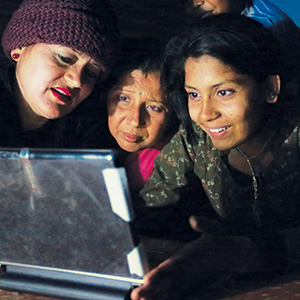

The three school-age Nunez daughters struggled with studying at home. It wasn’t for lack of motivation, nor overbooked after-school schedules—nor any obsessive relationships with the Xbox. The girls’ home in the rural community of Colonet, Mexico, had no electricity. After sundown, the sisters squinted at their homework, trying to read and write by the dim light of a few small votive candles.
“You can’t study effectively if you’re trying to study with a candle—you just don’t have the illumination. It’s also very expensive, and kerosene and candles are a health hazard … I thought I had to do something about it, but I wasn’t sure what it was at the time,” says Jesse Salem, who befriended the Nunez family on one of his trips to Colonet.
Salem has traveled to Colonet for the past 20 years to build houses with the Los Gatos United Methodist Church. But one year he noticed that it wasn’t just homes that needed construction.
He says that about one-third of the people in Colonet—a small, agricultural town in the Baja California peninsula—live off-grid, unable to connect to electricity because the power lines are at least a half-mile away. Worldwide, the number of people living without electricity stands around 1.5 billion, 85 percent of whom are illiterate.
For Salem, the connection was clear—get better lighting, and kids will read, write and perform better in school.
So Salem, a retired materials engineer who spent 26 years working for IBM, went back to his home in Cupertino and in 2012, came up with a solution: solar-powered LED lights small enough to bring with him on his next trip to Colonet, but powerful enough to illuminate an entire room for four hours straight. This simple solar lighting solution spawned the nonprofit Lighting for Literacy.
Salem’s solar units are comprised of three main components: a 10-watt solar panel about a square-foot large comes with a steel-angle bracket so it can be mounted onto the roof of a house to maximize sun exposure; a small, gray plastic box that holds the battery and charge control, which converts the output from the solar panel into electricity to fuel a thin, quarter-inch by 15-inch, 640 lumen LED strip. “It’s almost as good as a 60-watt light bulb,” says Salem.
Salem, who works part-time at San Francisco’s Exploratorium, started taking the solar-powered units with him each time he visited Mexico, so that now there are 16 fully functioning lighting units in Colonet. Relying on funding from the Los Gatos Morning Rotary and Cupertino Electric, he sent another 15 to Zambia, where he also has connections on the ground, and plans to start shipping to Ghana as well. “The initial reports are that yes, the children who have gotten the lighting systems are doing better in school,” he says. “Their grades are going up.”
Lighting for Literacy is just one of many Silicon Valley organizations drawing on innovative technology as a way to address problems such as poverty and illiteracy abroad. “Because we’re in the Bay, where things that are new and exciting are always at the forefront of people’s minds, I think you see a lot of nonprofits doing cutting-edge work,” says Brian Mattos of the Silicon Valley Council of Nonprofits.
According to Jennifer Shea, an assistant professor in the public administration program at San Francisco State University, these kinds of technology-based service groups started popping up in the mid-1990s in an attempt to provide solutions to a variety of problems in the developing world, from clean water and sanitation to solar powered ovens. Their emergence coincided with the larger, more established humanitarian organizations—such as Oxfam and CARE—moving away from direct service and toward a partnership model in which they fund smaller, grassroots organizations to do all the on-the-ground work.
In addition to pioneering new types of technology, many of these groups have also taken on new business models, so that instead of operating as traditional nonprofits they have incorporated elements of start-ups and for-profit businesses. “What differentiates social enterprise from typical nonprofits is that they’re more open to business principles and partnering with corporations, and are looking for a creative solution without worrying about the questions of whether it should be a government, nonprofit or business doing it,” says Shea. “They’re very problem-focused, innovative risk takers.”
The growth of this new breed of organization also highlights the ongoing exchange between technological innovation and charitable organizations. Just as the technology giants have started to address social and economic issues in poor countries—for example, Mark Zuckerberg’s promise last year to bring Internet to the 5 billion people in the world presently without it—so too are nonprofits harnessing technology as a way to solve problems.



